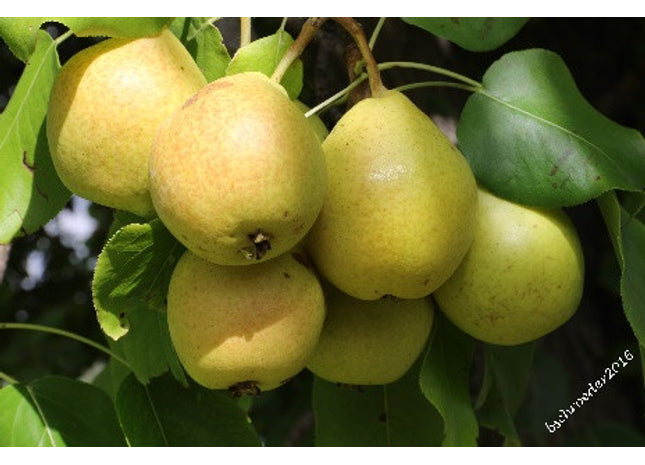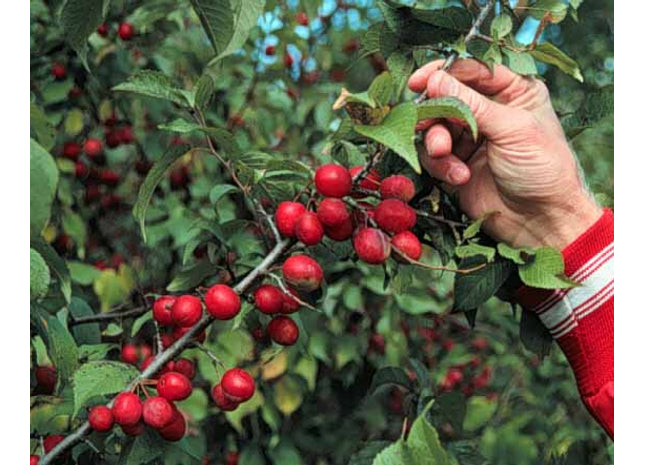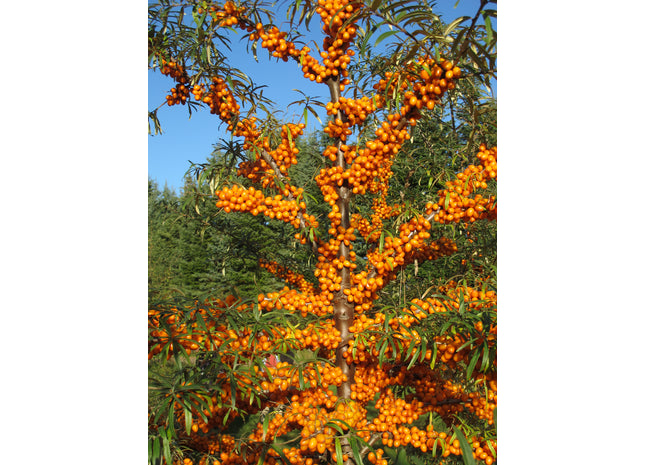Fruiting Trees & Shrub Seeds

AgroForestry Solutions 'George Kennedy' Ussurian Pear Seed
Latin Name: Pyrus ussuriensis DESCRIPTION Family: Rosaceae Native Range: Northeast Asia Seed Source: Ussurian pear growing in a seed production orchard near Indian Head Saskatchewan. Height and Spread: 7m x 4m Overview: 'George Kennedy' Ussurian pear is well adapted to cold temperate regions. Its vigorous, dense growth makes it useful for shelterbelts. The attractive flowers and yellow-orange autumn color enhance its aesthetic value. Short, stubby branches (spurs), that are thorn-like, form before developing into another branch. The seed strain was named in honour of George Kennedy an early Tree Inspector at Indian Head Fruits: Pear-shaped and 3-4 cm in diameter with multiple seeds. Ripens in September. Average number of seeds/packet: 200 SEED TREATMENT / SOWING Stratification: Stratify in moist sand (10% moisture) for 90 days at 5°C. Ideal sowing time: Non-pretreated seed outdoors in late September (will germinate the following spring) or stratified seed in spring. Sowing instructions: Outdoors - Sow 2 cm deep and 50 seeds/meter; Greenhouse - sow 3 seeds per cell 1 cm deep. Growing conditions: ‘George Kennedy’ Ussurian pear is well-adapted to most soil types except heavy, poorly drained, and high lime soils. It performs very well on sandy soils. AGROFORESTRY VALUE The 'George Kennedy' seed strain is excellent for field and farmstead shelterbelts, intercropping, reclamation, and wildlife habitat plantings. All plants produce fruit. The fruit is hard, but may be used for jams and jellies and sweetens after a frost.
$25.00

AgroForestry Solutions 'Hudson Bay' American Plum Seed
Latin Name: Prunus americana DESCRIPTION Family: Rosaceae Native Range: Native to southern Canada from Saskatchewan in the west to Quebec Seed Source: Seed production stand near Indian Head, Saskatchewan. Height and Spread: 5m x 3m (5 years) Overview: The 'Hudson Bay' American plum seed strain is adapted to cold temperate dry climates. This strain comes from a shelterbelt growing near Hudson Bay Saskatchewan. A pioneer plant quickly colonizing sites this seed strain produces bright red edible plums. Wild plum is a shrub or small tree 3-8 m tall, and usually found growing as dense thickets. Fruits: Reddish-purple oval plums 2.0-2.5 cm long containing one seed. Average number of seeds per packet - 50 SEED TREATMENT / SOWING Stratification: Pre-soak seed for 24 hours then stratify in moist sand (10 percent moisture) for 180 days at 5°C. Ideal sowing time: Non-pretreated seed outdoors in early September (will germinate the following spring) or stratified seed in spring. Sowing instructions: Outdoors - sow 2.0 cm deep, 50 seeds/meter; Greenhouse - sow 3 seeds per cell. Growing conditions: American plum grows well on a wide range of soils. As a colonizer, it will flourish on most disturbed sites. It prefers full sunlight and is considered somewhat drought tolerant and cold hardy. AGROFORESTRY VALUE American plums make good wildlife habitat and are effective in erosion control because their roots hold the soil. Their thorny branches catch tumbleweeds, leaves, and other plant materials, which, when windstorms occur during times of drought, provide an effective means of slowing wind erosion of soil.
$25.00

AgroForestry Solutions 'Indian-Summer' Seabuckthorn Seed
Latin Name: Hippophae rhamnoides ssp. Mongolica DESCRIPTION Family: Elaeagnaceae Native Range: Europe and Asia Seed Source: Seed production orchard near Indian Head, Saskatchewan. Height and Spread: 4m x 2m (10 years) Overview: A wonderful plant recognized by many as one of the most nutritional berries in the plant kingdom. A nitrogen fixer, the 'Indian -Summer' seed strain is extremely hardy and adapted to low quality, droughty soils. Seeds produce a mixture of male and female plants. Fruits: An orange drupe-like achene 3 to 6mm long. Berries remain on shrubs over winter. Average number of seeds/packet: 240 SEED TREATMENT / SOWING Stratification: Soak the seeds for 24 hours, then stratify in moist sand (10 percent moisture) for 60 days at 5C. No treatment needed if down outdoors in late September (Germination occurs the following spring). Ideal sowing time: Spring Sowing instructions: Outdoors - sow 1 cm deep and 50 seeds/meter; Greenhouse- sow 3 seeds per cell. Growing conditions: 'Indian-Summer' grows well on a variety of soils, requires full sunlight, does not tolerate shade. AGROFORESTRY VALUE 'Indian-Summer' is an excellent seed strain for farm or field shelterbelts, intercropping, reclamation, and wildlife habitat plantings. The seed strain was developed specifically for agroforestry, stabilizes eroding soil, contributes nitrogen, and provides wildlife valuable cover. It is often used as a pollinator row in seabuckthorn orchards. One of the most versatile agroforestry plants. Harvest Seabuckthorn berries Your browser does not support our video Your browser does not support our video
$25.00

AgroForestry Solutions 'Mackintosh' Western Sand Cherry Seed
Latin Name: Prunus besseyi DESCRIPTION Family: Rosaceae Native Range: Canada and the Northern United States Seed Source: Seed production orchard near Indian Head, Saskatchewan. Height and Spread: 1.5m x 1.5m Overview: 'Mackintosh' Western Sand Cherry cherry is an excellent choice for agroforestry planting in cold temperate regions. This seed strain was selected because of its consistent production of large yields of black cherries. It is named for Angus Mackintosh a tree inspector at the Dominion Forest Nursery Station in Indian Head from 1904 to 1916, a nature enthusiast and former employee at the PFRA Tree Nursery. Fruits: Black fruit borne in clusters, 12-15mm across. Average number of seeds/packet: 110 SEED TREATMENT / SOWING Stratification: Soak seeds for 48 hours then stratify in moist sand (10 percent moisture) for 90 days at 5°C. Ideal sowing time: Non-pretreated seed outdoors in September (will germinate the following spring) or stratified seed in spring. Sowing instructions: Outdoor seedbed - Sow 2 cm deep and 50 seeds/meter; Greenhouse - sow 3 seeds per cell 1 cm deep. Growing conditions: Western sand cherry will thrive under just about every condition imaginable, except for heavy shade. AGROFORESTRY VALUE 'Mackintosh' Western Sandcherry is known for its unique, leathery grey-green foliage and beautiful white blossoms. It is a popular ornamental shrub in parks and front yards. Both you and the wildlife will love its edible small dark red to purple cherries. Fruit can be astringent but is great for jams, jellies and pies. Extremely winter hardy. Many people graft plum and cherry varieties to Western Sand Cherry and use it as rootstock. It is also popular to graft hardy apricots too.
$20.00 - $25.00

AgroForestry Solutions 'Midnight' Choke Cherry Seed
Latin Name: Prunus virginiana DESCRIPTION Family: Rosaceae Native Range: Canada and the Northern United States Seed Source: Natural stand growing near Jansen Lake, Saskatchewan. Height and Spread: 7m x 4m Overview: 'Midnight' Choke cherry is an excellent choice for agroforestry planting in cold temperate regions. This seed strain was selected many years ago by a local farmer because of its consistent production of large yields of black cherries. Fruits: Black fruit borne in clusters, 8-12 mm across. Average number of seeds/packet: 150 SEED TREATMENT / SOWING Stratification: Stratify in moist sand (10 percent moisture) for 30 days at room temperature (20°C) followed by 120 days at 5°C. Ideal sowing time: Non-pretreated seed outdoors in July (will germinate the following spring) or stratified seed in spring. Sowing instructions: Outdoor seedbed - Sow 2 cm deep and 50 seeds/meter; Greenhouse - sow 3 seeds per cell 1 cm deep. Growing conditions: Choke cherry will thrive under just about every condition imaginable, except for heavy shade. AGROFORESTRY VALUE 'Midnight' choke cherry is an excellent seed strain for field and farmstead shelterbelts, intercropping, reclamation, and wildlife habitat plantings. All plants produce fruit that can be used for berry harvest. The fruit is astringent but edible and makes excellent juice, syrup, or jelly.
$25.00

AgroForestry Solutions 'Ralph Dunlop' Silver Buffaloberry Seed
Latin Name: Shepherdia argentea DESCRIPTION Family: Elaeagnaceae Native Range: Canadian Prairie Provinces, United States Northern Great Plains. Seed Source: Natural stand near Indian Head Saskatchewan. Height and Spread: 4m x 2m (10 years). Overview: The 'Ralph Dunlop' seed strain was developed for tree planting in the Canadian prairies. This strain originates from a natural stand of buffaloberry with above average berry size. The strain is named in honour of Ralph Dunlop a tree planting technician at the Indian Head Forest Nursery Station from 1924 to 1961. Buffaloberry is a wonderful plant recognized by many as one of the most nutritional berries in the plant kingdom. Seeds produce a mix of male and female plants. Fruits: A red drupe-like achene 3 to 6mm long. Average number of seeds/packet: 750 SEED TREATMENT / SOWING Stratification: Stratify in moist sand (10% moisture) for 90 days at 5°C. Ideal sowing time: Non-pretreated seed outdoors in late September, Stratified seed in spring Sowing instructions: Outdoors - Sow 1 cm deep and 50 seeds/meter; Greenhouse - sow 3 seeds per cell 1 cm deep. Growing conditions: The seed strain requires full sunlight and does not tolerate shade. It is a nitrogen fixer, extremely hardy, and adapted to low-quality, dry soils. Excellent for the farmstead, intercropping, reclamation, Eco-Buffers, and wildlife habitat plantings. AGROFORESTRY VALUE 'Ralph Dunlop' Buffaloberry is an excellent choice for farmsteads, intercropping, reclamation, and wildlife habitat plantings. This seed strain was bred and developed specifically for temperate agroforestry. Buffaloberry stabilizes eroding soil, contributes nitrogen, and provides wildlife valuable cover, particularly upland game birds. Female plants can be used for fruit production. Your browser does not support our video
$35.00

AgroForestry Solutions 'Reay' Nannyberry Seed
Latin Name: Viburnum lentago DESCRIPTION Family: Caprifoliaceae Native Range: Southern Canada and the northern United States west to Eastern Saskatchewan. Seed Source: Natural stand growing near Thunderhill, Manitoba. Height and Spread: 4m x 2m (10 years) Overview: The ‘Reay’ seed strain has proven to be well adapted for tree planting in the Canadian prairies. It is a composite of selected parent trees from natural stands. The seed strain is named in honour of John Reay, a tree planting inspector at the Forest Nursery Station from 1914 to 1924. Fruits: Bluish-black drupe, 8-12 mm long with thin sweet edible flesh. Average number of seeds/packet: 150 SEED TREATMENT / SOWING Stratification: Pre-soak seed for 24 hours then stratify in moist sand (10 % moisture) for 180 days at 20oC followed by 90 days at 5oC. Ideal sowing time: Non-treated seed in summer (will germinate the following spring) or stratified seed in spring. Sowing instructions: Outdoor seedbed - Sow 1.5 cm deep and 50 seeds/meter; Greenhouse - sow 2 seeds per cell 1 cm deep. Growing conditions: Grows in full sunlight and shade. It is extremely hardy and prefers moist soils. It will colonize a site with root suckers. AGROFORESTRY VALUE 'Reay' nannyberry is an excellent choice for windbreaks, EcoBuffers, and wildlife habitat plantings. This seed strain was developed specifically for agroforestry planting. Nannyberry stabilizes eroding soil and provides wildlife valuable cover. It produces nutritious sweet berries.
$25.00

AgroForestry Solutions 'Waxwing' Siberian Crab Seed
Latin Name: Malus baccata DESCRIPTION Family: Rosaceae Native Range: Native to central and eastern Siberia. Seed Source: Seed production orchard near Indian Head Saskatchewan. Height and Spread: 6m x 5m (5 years). Overview: The 'Waxwing' seed strain was developed for prairie tree planting. It is a composite of selected Siberian crabapple trees. This seed strain is ideally suited for agroforestry planting. It is fast-growing and provides excellent food and cover for wildlife. Fruit: Multi-seeded apples are either red or yellow and vary in size from 1-2 cm. Average number of seeds/packet: 800 SEED TREATMENT / SOWING Stratification: Water soak for 72 hours then stratify in moist sand (10 percent moisture) for 10 days at 5°C. Ideal sowing time: Non-pretreated seed outdoors in late September (will germinate the following spring) or stratified seed in spring. Sowing instructions: Sow 1.0 cm deep,50 seeds/meter; Greenhouse - sow 3 seeds per cell. Growing conditions: ‘Waxwing’ Siberian crab favors medium to heavy soils that are somewhat poorly to well-drained with a pH of 5.5 to 7.0. Full sun is preferred for best performance, but they will tolerate light shade. AGROFORESTRY VALUE 'Waxwing' Siberian crab is used in shelterbelts, Eco-Buffers, and wildlife habitat plantings. It provides good food and cover for birds. The fruit is eaten by birds during winter, they attract large flocks of cedar waxwings.
$25.00 - $175.00

AgroForestry Solutions Highbush Cranberry Seed
Latin Name: Viburnum trilobum DESCRIPTION Family: Caprifoliaceae Native Range: Southern Canada and the northern United States west to Eastern Saskatchewan. Seed Source: A natural stand near Chelan, Saskatchewan. Height and Spread: 4m x 2m (10 years) Overview: The seed strain has proven to be well adapted for tree planting in the Canadian prairies. It is a composite of selected parent trees in natural stands. Fruits: Red drupe, 8-12 mm long with thin sour-sweet edible flesh. Average number of seeds/packet: 300 SEED TREATMENT / SOWING Stratification: Soak seed 72 hours then stratify in moist sand (10 percent moisture) for 140 days at 20⁰C. When germinations starts to occur in bag, sow into a flat of peat moss in warm conditions until seeds sprout. Transplant sprouted seed to containers. Ideal sowing time: Non-treated seed in summer (will germinate the following spring) or stratified seed in spring. Sowing instructions: Outdoor seedbed - Sow 2.0 cm deep and 75 seeds/meter; Greenhouse - sow 3 seeds per cell 1 cm deep. Growing conditions: Grows in full sunlight and shade. It is extremely hardy and prefers moist soils. It will colonize a site with root suckers. AGROFORESTRY VALUE Highbush cranberry is an excellent choice for windbreaks, EcoBuffers, and wildlife habitat plantings. This seed strain was developed specifically for agroforestry planting. Highbush cranberry provides wildlife valuable cover. It produces nutritious sour-sweet berries.
$25.00

AgroForestry Solutions Mongolian Cherry Seed
Latin Name: Prunus fruticosa DESCRIPTION Family: Rosaceae Native Range: An introduced shrub from Asia. Seed Source: Seed production orchard near Indian Head, Saskatchewan. Height and Spread: 2m x 2m (5 years) Overview: The Mongolian cherry seed is ultra-hardy and adapted to cold temperate climates. It was developed specifically for agroforestry planting. Mongolian cherry produces high yields of edible tart cherries. The fruit is much sweeter if cooked or dried. Fruits: A round single-seeded purplish-red cherry, 1.5 cm in diameter. Average number of seeds/packet: 75 SEED TREATMENT / SOWING Stratification: Stratify in moist sand (10 percent moisture) for 120 days at 5oC. Ideal sowing time: Non-pretreated seed outdoors in late September (will germinate the following spring) or stratified seed in spring. Sowing instructions: Sow 2.0 cm deep, 50 seeds/meter; Greenhouse - sow 3 seeds per cell. Growing conditions: ’Brilliant’ Mongolian cherry grows well on medium-textured soils with soil pH 7.0 to 8.0. Agroforestry Value Mongolian Cherry is used in farmstead and field shelterbelts, Eco-Buffers, wildlife habitat, and fruit orchard plantings. Many song and game birds utilize this shrub for food and habitat. The cherries can be eaten fresh, preserved as jelly, or dried.
$20.00

AgroForestry Solutions Nanking Cherry Seed
Latin Name: Prunus tomentosa DESCRIPTION Family: Rosaceae Native Range: Northern and western China and Mongolia Seed Source: Seed production orchard near Indian Head, Saskatchewan. Height and Spread: 1.5m x 1.5m Overview: Nanking Cherry cherry is an excellent choice for fruit gardens or agroforestry planting in cold temperate regions. It also makes an attractive hedge. This seed strain was selected because of its consistent production of tangy red cherries. Cross pollination is required for fruit production so more than one plant is required. Fruits: Cherry red drupe. Average number of seeds/packet: 100 SEED TREATMENT / SOWING Stratification: Soak seeds for 24 hours then stratify in moist sand (10 percent moisture) for 100 days at 5°C. Ideal sowing time: Non-pretreated seed outdoors in late July or early August (will germinate the following spring) or stratified seed in spring. Sowing instructions: Outdoor seedbed - Sow 2 cm deep and 50 seeds/meter; Greenhouse - sow 3 seeds per cell 1 cm deep. Growing conditions: Nanking cherry is hardy and will grow in a variety of soils but will not tolerate heavy shade. AGROFORESTRY VALUE Nanking cherry is known for its fragrant pink flowers along its branches in the spring, with forest green foliage. It is a good choice for attracting birds. Both you and the wildlife will love its edible red cherries. Fruit can be tangy but is great for jams, jellies, and pies. Extremely winter hardy.
$25.00

AgroForestry Solutions Saskatoon Berry Seed
Latin Name: Amelanchier alnifolia DESCRIPTION Family: Rosaceae Native Range: Native to the Canadian prairies. Seed Source: Nortlhline Saskatoon berry orchard growing near Leroy Saskatchewan. Height and Spread: 3m x 2m (5 years) Overview: This saskatoon berry seed strain is a bountiful berry producer. These bushes have been an excellent source of berries since the 1950’s. It is characterized by reliable berry production of flavourful medium-sized berries. This strain is adapted to a wide range of growing conditions. Fruit: Berry-like pomes up to 1.0 cm in diameter containing a single seed. Average number of seeds/packet: 600 SEED TREATMENT / SOWING Stratification: Pre-soak seed for 24 hours then stratify in moist sand (10% moisture) for 90-120 days at 5°C. Ideal sowing time: Non-pretreated seed outdoors in late September (will germinate the following spring) or stratified seed in spring. Sowing instructions: Outdoors - sow 1.0 to 1.5 cm deep, 50 seeds/meter; Greenhouse - sow 3 seeds per cell. Growing conditions: Saskatoon berry grows on a wide variety of soils but favors moist, loamy soils with a pH of 5.0 to 8.0. It is shade tolerant but prefers a sunny exposure. AGROFORESTRY VALUE Saskatoon berry is used in shelterbelts, Ecobuffers, and wildlife habitat plantings. The dense roots and rhizomes of Saskatoon make it useful for soil stabilization and erosion control on moist sites including streambanks. It provides good food and cover for birds plus small and large mammals. The berries are highly edible and are a prized fruit-producing plant in the home garden or commercial orchard.
$30.00












